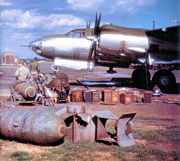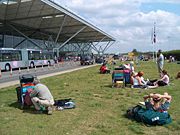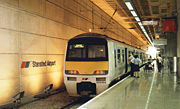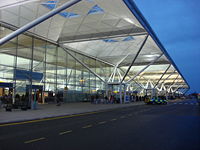London Stansted Airport
| London Stansted Airport |
|||
|---|---|---|---|
|
|
|||
| IATA: STN – ICAO: EGSS | |||
| Summary | |||
| Airport type | Public | ||
| Owner/Operator | BAA | ||
| Serves | London | ||
| Location | Uttlesford | ||
| Elevation AMSL | 348 ft / 106 m | ||
| Website | |||
| Runways | |||
| Direction | Length | Surface | |
| m | ft | ||
| 05/23 | 3,048 | 10,000 | Grooved Asphalt |
| Statistics (2007) | |||
| Aircraft Movements | 208,462 | ||
| Passengers | 23,779,697 | ||
| Source: United Kingdom AIP [1]
Statistics from the UK CAA[2] |
|||

London Stansted Airport (IATA: STN, ICAO: EGSS) is a passenger airport located in the Uttlesford District of the English county of Essex about 38 miles (61 km) north-east of central London. It is about 2 miles (3 km) outside Bishop's Stortford and 6 miles (10 km) outside Harlow.
Stansted is a hub for a number of major European low-cost carriers. It is the third busiest airport in the United Kingdom and is the third largest airport serving the London area after Heathrow and Gatwick; and it is one of London's five international airports along with Luton and London City Airports. Stansted is owned and operated by BAA, which also owns and operates six other UK airports[3], including Heathrow and Gatwick, and is itself owned by an international consortium led by the Spanish Ferrovial Group.[4]
Contents |
Overview
Stansted Airport has one main passenger terminal, a private aircraft terminal and a cargo station. There are three passenger satellites in which the departure gates are situated, two connected to the main terminal by an air-bridge and the other by the Stansted Airport Transit System people mover. The terminal facilities include several bureaux de change, luggage services, shops, restaurants and bars as well as internet access. Car hire and taxis can also be arranged from within the terminal building.
The terminal building was designed by Foster Associates and features a "floating" roof, supported by a space frame of inverted-pyramid roof trusses, creating the impression of a stylised swan in flight. The base of each truss structure is a "utility pillar", which provides indirect uplighting illumination and is the location for air-conditioning, water, telecommunications, and electrical outlets. The layout of the airport is designed to provide an unobstructed flow for passengers to arrive at the short-stay car park, move through the check-in hall, go through security and on to the departure gates all on the same level.
From 1997 to 2007 Stansted saw rapid expansion of passenger numbers on the back of the boom in low cost air travel, peaking at 24 million passengers in the 12 months to October 2007, but since then passenger numbers have been in decline.
History
World War II


During World War II Stansted Mountfitchet Airfield was used by the Royal Air Force and the United States Army Air Force as a bomber airfield and as a major maintenance depot. Although the official name was Stansted Mountfitchet, the base was known as simply Stansted in both written and spoken form.
The station was first allocated to the USAAF Eighth Air Force in August 1942 as a bomber airfield. Its USAAF Station Code was 169. Later, in October, Stansted was selected to be an advanced air depot for the 9th Air Force Martin B-26 Marauder medium bombers. Construction was carried out by the United States Army 817th, 825th and 850th Engineering Battalions, which completed the airfield by mid-1943.
344th Bombardment Group
Stansted was officially opened on 7 August 1943 when the 30th Air Depot Group took up residence. The airfield was officially transferred to the Ninth Air Force on 16 October.
The 344th Bombardment Group arrived at Stansted on 8 February 1944, from Hunter Army Airfield in Georgia flying the twin-engine B-26 Marauder. Its operational squadrons and fuselage codes were 494th (K9), 495th (Y5), 496th (N3), and 497th (7I).
The 344th BG began operations in March 1944, attacking airfields, missile sites, marshaling yards, submarine shelters, coastal defenses and other targets in German-occupied France, Belgium, and the Netherlands. Beginning in May, the 344th helped prepare for the Normandy invasion by striking vital bridges in France.
The 344th Bombardment Group was selected to lead the IX Bomber Command formations on D-Day, with the first aircraft taking off at 04:12 hours to attack coastal batteries in Cherbourg. During the remainder of June it supported the drive that resulted in the seizure of the Cotentin Peninsula.
The unit also defended positions to assist British forces in the area of Caen and received a Distinguished Unit Citation for a three-day action against the enemy in late July when the group struck troop concentrations, supply dumps, a bridge and a railroad viaduct to assist advancing ground forces at St Lo.
On 30 September the 344th moved to their Advanced Landing Ground at Cormeilles-en-Vexin, France). While at Stansted the group flew over 100 missions and lost 26 aircraft in combat.
2d Tactical Air Depot
As well as being an operational bomber base, Stansted airfield was a maintenance and supply depot concerned with major overhauls and modification of B-26s. After D-Day these activities were transferred to France, but the base was still used as a supply storage area for the support of aircraft on the continent.
Postwar use
After the withdrawal of the Americans on 12 August 1945, Stansted was taken over by the Air Ministry and used by No. 263 Maintenance Unit, RAF for storage purposes. In addition, between March 1946 and August 1947, Stansted was used for housing German POWs. The Ministry of Civil Aviation finally took control of Stansted in 1949, but the US military returned in 1954 to extend the runway for a possible transfer to NATO. The transfer to NATO was never realised, however, and the airport returned to civil use in 1957, ending up under BAA control in 1966.
During the 60s, 70s and early 80s the Fire Service Training School (FSTS) was based on the Eastern side of the Airfield under the auspices of the Ministry of Transport and Civil Aviation, now the Civil Aviation Authority. The School was responsible for the training of all Aviation Fire Crews for UK Airfields as well as for many overseas countries.
Commercial operations


Beginning in 1966, after Stansted was placed under BAA control, the airport was used by holiday charter operators wishing to escape the higher costs associated with operating from Heathrow and Gatwick. From the outset, however, BAA and the British government planned to develop Stansted into London's third airport, to relieve Heathrow and Gatwick of excess congestion in the future. The airport's first terminal building opened in 1969 and was expanded the next year to handle the growing number of passengers.
In 1984, the government approved a plan to develop Stansted in two phases, involving both airfield and terminal improvements that would increase the airport's capacity to 15 million passengers per year. Construction of the current terminal building began in 1988 and was completed in March 1991, and was designed by the internationally acclaimed Sir Norman Foster.
Long-haul scheduled services became reality in the early 1990s when American Airlines operated a transatlantic service between Stansted and Chicago. This was unprofitable and was withdrawn, however. Continental Airlines also operated services in the late 1990s from Newark using a Boeing 757-200, but this service was stopped shortly after September 11, 2001. The first long-haul scheduled service that has lasted at Stansted has been Israeli airline El Al's flights between Stansted and Tel Aviv, following an excess of demand for its flights at Heathrow. This service was followed by another Israel airline, Israir Airlines.
Long-haul services to the USA returned in late 2005, when Eos Airlines and MAXjet Airways commenced all-business-class services from Stansted to New York-JFK, with EOS using a Boeing 757-200 and MAXjet using a 767-200. In 2006, MAXjet expanded their service with flights to Washington DC, Las Vegas and Los Angeles. American Airlines began daily flights to Stansted in October 2007 from New York-JFK Airport and was originally expected to operate a second daily flight in April 2008. However, all three services to the USA have now ceased again. MAXjet Airways ceased operations on December 24, 2007, while in April 2008 Eos Airlines filed for Chapter 11 bankruptcy, and ceased all operations. Finally, in July 2008 American Airlines withdrew from the airport, spelling the end of Stansted transatlantic passenger operations.
Stansted also had scheduled and charter flights to Toronto, Montreal and Vancouver, but these flights to Canada have now ceased. Also at one time, Pakistan International Airlines had a twice-weekly service from Stansted to Karachi and a weekly flight to Islamabad via Karachi using Airbus A310 aircraft.
Long-haul services to Asia are due to start in March 2009 with Malaysian low-cost airline Air Asia X providing direct flights to Kuala Lumpur using a leased Airbus A340-300.
Proposed expansion
The airport capacity is limited to a maximum throughput of 25 million passengers per annum (25mppa) in accordance with recommendations made by the public inquiry in 1984 and confirmed by the Government of the day. In November 2006 Uttlesford district council rejected a BAA planning application to increase the permitted number of aircraft movements and to remove the limit on passenger numbers. BAA immediately appealed against the decision and a public inquiry was launched that lasted from May to October 2007. Planning Inspector Alan Boyland made his recommendations in January 2008. Those recommendations were largely followed by the Secretary of State for Transport (Geoff Hoon) and the Secretary of State for Communities and Local Government (Hazel Blears), who jointly allowed the applicant's Appeal in October 2008. Essex County Council may challenge the decision on the basis that ministers overruled the Inspector's advice on the numeric limitation of early morning and late night operations. [5]
On 11 March 2008 BAA submitted a planning application for the construction of a second runway and terminal, in line with a recommendation in the 2003 Air Transport White Paper. This will be the subject of another public inquiry, but if approved the second runway is expected to open in 2015 and will allow Stansted to handle more passengers than Heathrow does today.[6]
The proposed expansion came into conflict with the listed building rules when it emerged that 18 listed buildings would need to be demolished.[7]
In April 2007, a major expansion program to the existing terminal began. Works to add nearly 5,900 square metres of floorspace are underway and are designed to give space for additional baggage carousels, a new immigration and passport control hall and a hypostyle arrivals hall with improved facilities.
Stop Stansted Expansion
Stop Stansted Expansion (SSE) is a campaign group opposed to what they refer to as 'unsustainable' expansion of Stansted Airport. Its objective is "to contain the development of Stansted Airport within tight limits that are truly sustainable and, in this way, to protect the quality of life of residents over wide areas of Essex, Hertfordshire and Suffolk, to preserve our heritage and to protect the natural environment." The campaign group has over 6,000 individual members and has the support of more than 100 local authorities and other organisations. SSE has been fighting airport expansion by legal means since 2002, when a Department for Transport consultation suggested that Stansted could expand to up to 4 runways. In 2004/2005, SSE mounted a High Court challenge to the government White Paper on aviation transport policy and, although it did not manage to overturn the paper, the judge deemed that the widely-spaced runway option presented as the preferred option in the document was "a bridge too far" and a matter that should be decided through the normal planning procedures.
Airlines and destinations
Scheduled
| Airlines | Destinations |
|---|---|
| Aegan Airlines | Athens |
| AirAsia X | Kuala Lumpur [Begins 11 March 2009[8]] |
| Air Berlin | Düsseldorf, Hanover, Münster/Osnabrück, Nürnberg, Paderborn/Lippstadt |
| Air Malta | Malta |
| Air Moldova | Chişinău |
| Air Sylhet | Dubai, Vienna |
| Atlantic Airways | Faroe Islands |
| Albanian Airlines | Tirana |
| Aurigny Air Services | Guernsey |
| Blue Air | Brussels, Bucharest-Baneasa |
| Cyprus Airways | Larnaca |
| Cyprus Turkish Airlines | Antalya, Dalaman, Gazientep, Izmir, Lefkoşa |
| easyJet | Alicante, Amsterdam, Asturias, Barcelona, Belfast-International, Bilbao, Copenhagen, Edinburgh, Faro, Funchal, Geneva, Glasgow-International, Ibiza, Ljubljana, Lyon, Málaga, Munich, Naples, Newcastle, Nice, Palma de Mallorca, Prague, Tallinn |
| El Al Israel Airlines | Tel Aviv |
| Germanwings | Cologne/Bonn, Stuttgart |
| Iceland Express | Reykjavik-Keflavik |
| Norwegian Air Shuttle | Oslo-Gardermoen, Tromsø, Trondheim |
| Pegasus Airlines | Istanbul-Sabiha Gökçen, Lefkoşa |
| Ryanair | Aarhus, Agadir, Alghero, Alicante, Almeria, Altenburg, Ancona, Angouleme, Balaton [Starts 31st March], Bari, Basel/Mulhouse [begins 21 December], Belfast-City, Bergerac, Berlin-Schönefeld, Béziers, Biarritz, Billund, Bologna, Bratislava, Bremen, Brescia, Brindisi, Brno, Bydgoszcz, Carcassonne, Cork, Cuneo [begins 20 December], Derry, Dinard, Dublin, Eindhoven, Faro, Frankfurt-Hahn, Friedrichshafen, Fuerteventura, Gdańsk, Genoa, Girona, Glasgow-Prestwick, Gothenburg-City, Granada, Graz, Grenoble, Haugesund, Ibiza, Jerez, Karlsruhe, Katowice, Kaunas, Kerry, Klagenfurt, Knock, Kraków, Lamezia-Terme, La Rochelle, Limoges, Linz, Łódź, Lourdes [begins 20 December], Lübeck, Madrid, Malaga, Marseille, Milan-Bergamo, Montpellier, Murcia, Nantes, Newquay, Oslo-Torp, Palermo, Palma de Mallorca, Parma, Pau, Perpignan, Perugia, Pescara, Pisa, Poitiers, Porto, Poznan, Pula, Reus, Riga, Rimini, Rodez-Marcillac, Rome-Ciampino, Rzeszów, Salzburg, Santander, Santiago de Compostela, Seville, Shannon, Stockholm-Skavsta, Stockholm-Vasteras, Szczecin, Tampere, Tenerife-South, Toulon [seasonal], Tours, Trieste, Turin, Valencia, Valladolid, Venice-Treviso, Weeze, Wrocław, Zadar, Zaragoza, Zweibrücken |
| Sun d'Or International Airlines | Eilat-Ovda |
| Turkish Airlines | Istanbul-Ataturk |
Charter
| Airlines | Destinations |
|---|---|
| Air Europa | Las Palmas, Palma De Mallorca, Tennerife South [Seasonal] |
| BH Air | Bourgas [seasonal] |
| European Air Charter | Kos, Palma de Mallorca, Santorini [seasonal] |
| First Choice Airways | [Thomson Airways as of 1 May 2009] Arrecife, Bodrum, Bourgas, Corfu, Dalaman, Faro, Fuerteventura, Ibiza, Larnaca, Mahon, Palma de Mallorca, Paphos, Reus, Rhodes, Sharm el-Sheikh, Zakynthos [seasonal] |
| Iberworld | Las Palmas, Palma De Mallorca |
| Israir | Tel Aviv |
| Jet2.com | Palma Mallorca [seasonal], Lourdes |
| Monarch Airlines | Corfu, Menorca, Palma Mallorca, Tennerife-South |
| Onur Air | Bodrum, Dalaman [Seasonal] |
| Pegasus Airlines | Bodrum [Seasonal] |
| Skyways Express | Karlstad [Seasonal] |
| Thomas Cook Airlines | Antalya, Arrecife, Bodrum [seasonal], Dalaman [seasonal], Faro [seasonal], Fuerteventura, Ibiza [seasonal], Larnaca [seasonal], Mahon [seasonal], Monastir, Palma de Mallorca [seasonal], Reus [seasonal], Tenerife-South, Zakynthos [seasonal] |
| Thomson Airways | [From 1 May 2009] Antalya [begins 1 May], Arrecife [begins 7 May], Bodrum [begins 25 May], Corfu [begins 1 May], Dalaman [begins 4 May], Faro [begins 3 May], Fuerteventura [begins 2 May], Heraklion [begins 3 May], Ibiza [begins 2 May], Kefalonia [begins 3 May], Larnaca [begins 6 May], Mahon [begins 4 May], Palma de Mallorca [begins 2 May], Paphos [begins 2 May], Reus [begins 5 May], Rhodes [begins 6 May], Tenerife-South [begins 1 May], Zakynthos [begins 5 May] |
| Thomsonfly | [Thomson Airways as of 1 May 2009] Arrecife, Las Palmas, Paphos, Sharm el-Sheikh [begins 21 December], Tenerife-South |
| Titan Airways | Chambery [seasonal], Lourdes |
Cargo
| Airlines | Destinations |
|---|---|
| Asiana Cargo | Amsterdam, Seoul |
| BAC Express Airlines | Exeter |
| British Airways World Cargo operated by Global Supply Systems | Delhi, Mumbai, Atlanta, Chicago-O'Hare, Hahn, Hong Kong |
| FedEx Express | Amsterdam, Dublin, Glasgow-International, Indianapolis, Manchester, Memphis, Newark, Paris-Charles de Gaulle |
| FedEx Express operated by Air Contractors | Dublin, Glasgow-International, Manchester, Paris-Charles de Gaulle |
| Jet2.com | Edinburgh, Newcastle |
| Martinair Cargo | Amsterdam, San Juan |
| Royal Jordanian Airlines | Amman, New York-JFK |
| Titan Airways | Belfast-International, Edinburgh, Exeter |
| UPS Airlines | Cologne/Bonn, Newark |
Incidents and accidents
Stansted has been designated by the UK Government as its preferred airport for any hijacked planes requesting to land in the UK. This is because its design allows a hijacked airliner to be isolated well away from any terminal buildings or runways, allowing the airport to continue to operate while negotiations are carried out, or even while an assault or rescue mission is undertaken. Staff at the airport receive special training for dealing with hijack situations.[9] For this reason Stansted has been involved in more hijack incidents than might be expected for an airport of its size.
- On 31 March 1998 a chartered Hawker Siddeley HS-748 turbo prop (owned by Emerald Airways), carrying the Leeds United football team, suffered an engine explosion on take off resulting in an emergency landing and evacuation. All onboard survived, with only a few suffering minor injuries.[10]
- On 22 December 1999, Korean Air Cargo flight 8509, a Boeing 747, crashed shortly after take off from the airfield due to pilot error. The only people onboard at the time were the aircrew and all four were killed. The aircraft crashed in Hatfield Forest near the village of Great Hallingbury.
- On 6 February 2000 an Ariana Afghan Airlines Boeing 727 with 156 people on board was hijacked and flown to Stansted Airport. After a four-day stand-off the hostages on board were safely freed and the incident ended peacefully. It later emerged that the motive behind the hijack was to gain asylum in the UK, sparking debate about immigration into the country. A large number of passengers on board the plane also applied for asylum.[11] In July 2004, it was reported that a number of hijackers had won their bid for asylum in the UK, their convictions for hijacking having been quashed for misdirection of the jury in 2003.[12]
- On 27 February 2002 a Ryanair Boeing 737-800 aircraft operating Ryanair Flight 296 from Dublin to Stansted caught fire shortly after landing. Subsequent investigations found that although the aircraft was fully evacuated within 90 seconds, the air crew struggled to open the emergency doors, and some passengers were initially evacuated towards the fire. The UK Air Accidents Investigation Branch recommended changes to training procedures for air-crew to allow better handling of similar situations in future.[13]
Ground transportation

Trains
Stansted has a railway station below the terminal building, with rail services to Cambridge, Leicester and the Midlands every 60 minutes operated by CrossCountry. The Stansted Express train runs to and from Liverpool Street station in London every 15 minutes and the journey time is 45 minutes to one hour depending on traffic.
Coaches
Scheduled express bus or coach services run to and from Stratford, Victoria Coach Station, Liverpool Street Station and Golders Green (all in London), costing half as much as the train but taking longer (80 - 130 minutes). The bus/coach station is adjacent to the terminal building. National Express runs scheduled but infrequent direct coach services to the airport from Oxford as service JL737, taking about three hours, and hourly services to and from Cambridge. easyBus and Terravision provide journeys between the airport and Central London.
Roads
Stansted is connected to northeast London and Cambridge by the M11 motorway and to Colchester and Harwich by the A120 dual-carriageway. The long term car park is situated about a mile from the terminal and passengers need to allow at least twenty minutes to park and use a courtesy bus shuttle service prior to check-in. There are short term car parks next to the terminal building.
See also
- List of RAF stations
- USAAF Ninth Air Force - World War II
References
- ↑ UK Aeronautical Information Service
- ↑ Aircraft Movements - 2007, Terminal & Transit Passengers - 2007
- ↑ UK airports owned and operated by BAA
- ↑ BAA: "Who owns us?"
- ↑ ((cite news | url = http://www.essexcc.gov.uk/vip8/ecc/ECCWebsite/dis/ned.jsp?channelOid=124288&guideOid=124161&oid=126658))
- ↑ "£2.5bn Stansted Generation 2 planning bid submitted", Transport Briefing (12 March 2008).
- ↑ "BAA pays its own staff to lobby in favour of Stansted expansion", The Times.
- ↑ http://biz.thestar.com.my/news/story.asp?file=/2008/11/4/business/2449118&sec=business
- ↑ http://news.bbc.co.uk/1/hi/uk/633654.stm Stansted's Hijack History, BBC News, 7 February 2000
- ↑ Football: Leeds play on after flight ends in flames by Guy Hodgson from The Independent, 1 April 1998
- ↑ "Special report: Hijack at Stansted". BBC News (2000). Retrieved on 2007-04-05.
- ↑ "Afghans win right to stay in UK". BBC News (2004). Retrieved on 2007-04-05.
- ↑ "Boeing 737-8AS, EI-CSA" (PDF). Air Accidents Investigation Branch. Retrieved on 2007-04-05.
- Freeman, Roger A. (1994) UK Airfields of the Ninth: Then and Now. After the Battle ISBN 0900913800
- Maurer, Maurer (1983). Air Force Combat Units Of World War II. Maxwell AFB, Alabama: Office of Air Force History. ISBN 0892010924.
- [1] USAAS-USAAC-USAAF-USAF Aircraft Serial Numbers--1908 to present
- The Bishop's Stortford Herald newspaper, 26 April 2007.
| This article incorporates text from the Air Force Historical Research Agency website which, as a United States government publication, is in the public domain. |
External links
|
|||||||||||||||||||||||
|
||||||||||||||||||||||||||||||||||||||||||

